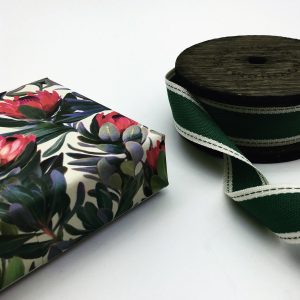Menu
GSM for Gee Whiz Wraps.
Today we are going to deal with a three letter acronym whose misinterpretation threatens every bit on paperwork you will ever undertake.
Fortunately, it isn’t ATO. No, this acronym can be even more insidious. It is the dreaded GSM.
Actually, GSM as a concept isn’t that complex. It’s just that being bamboozled with it when we are in a rush at Officeworks has resulted in more messed up paper than a rouge shredder. It’s an acronym that technically only gives one detail about a piece of paper, but incorrectly gets used as a catch all term.
Today we will look at GSM from the gift wrappers perspective and get an understanding of what it is, why it is and how to take that acronym and make it work for you.
GSM stands for Grams per Square Meter, and means that if you had a square of (for example) 80 GSM paper 1 meter to a side, rolled it up and slapped in on a scale it would weigh 80 grams.

GSM is a paper trade term used to give a quick shorthand measurement of the quality of paper. Generally higher GSM papers will have higher quality, but you shouldn’t rely on just the GSM of a paper to tell you everything about it.
Papers can be made, textured, coloured, filled and coated in an infinite number of ways, and the GSM has nothing really to do with these properties. Most importantly GSM is not linked to paper thickness. Higher GSM papers will generally be thicker than low GSM paper, but paper makers have many tricks up their sleeves and by adding foaming compounds or fillers can create quite thick paper with a low GSM.
From a gift wrappers perspective we need to understand that most standard copy paper is 80 GSM. Most quality gift wrapping paper is as well, although the weight of the ink is included in that GSM number. This is why wrapping paper generally feels a little more flimsy than copy paper.

Very cheap wrapping paper will be around the 55 GSM range. Since it will nearly always be printed, and sometimes given a coating to make it feel smooth, there is only the bare minimum of real paper in the mix. This explains why it is so fragile and difficult to work with.
When gift wrapping the best way to deal with GSM is as a general guide. Papers around 80 GSM will give the crisp folds and flat sides gift wrappers love. Paper with 100 GSM or greater will be a little more difficult to work with, resisting clean folds and refusing to be worked into position.
Cheap, low GSM papers should be avoided. Although the price may seem attractive, the wraps you make with them probably won’t be. Remember that gift wrapping is not just a visual art. The weight and feel of a wrap form a large part of the enjoyment, and cheap paper does not communicate the effort you put in.
The only exception to the 80 GSM range is wrapping projects that involve a lot of folding or gathering or paper, like wrapping conical or spherical objects such as balls and of course flower pots. In these situations its best to move away from traditional wrapping paper altogether, and move to tissue paper or paper with more than a bit of give.

Image Nashville Wraps
But tissue paper like anything else must be matched to the object and the occasion. So when you do match appropriately weighted paper with the shape of the gift and some precision folding it really is OMG GSM.
9 Chester Street
Newstead QLD 4006
0423 833 713
Mon-Sat 9am-5pm
Sun 9am-3pm
1234 High Street
Armadale VIC 3143
(03) 9500 1335
Mon-Sat 10am-5pm
Shop 2, 237 Given Terrace
Paddington QLD 4064
(07) 3162 9683
Mon-Sat 9am-5pm